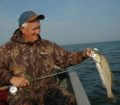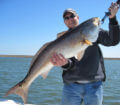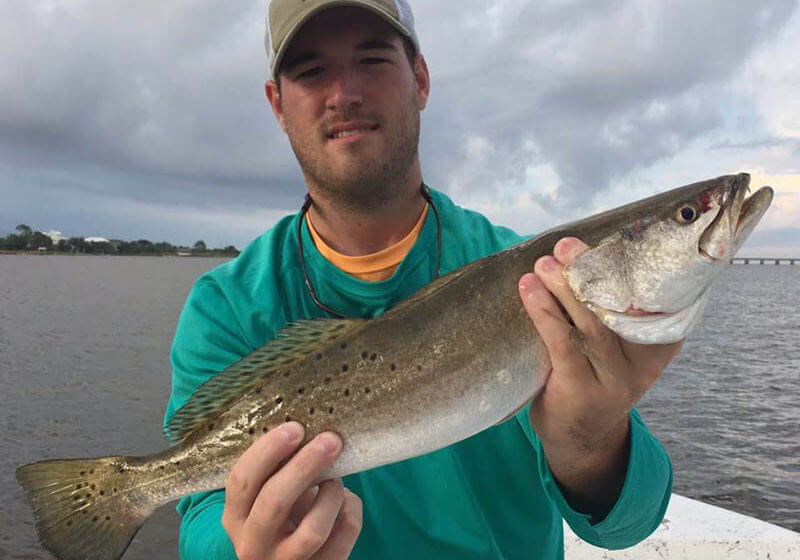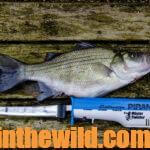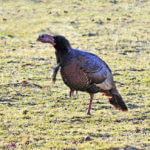John’s Note: October speckled trout hold on two types of reefs – public reefs and semi-public reefs. Public reefs consist of manmade reefs, oyster reefs or other types of bottom structure that everyone has pinpointed. The same kinds of structures that fewer folks know about comprise semi-public reefs. However, even if you choose to fish a semi-public reef in hopes that you’ll have the fish all to yourself, you won’t keep that spot secret for long. Coastal waters have become so heavily fished that few secret fishing spots remain. If you fish a reef near a large concentration of fishermen, the other anglers will see you fishing that reef and learn of its location. If you catch several speckled trout on that reef and anyone sees you, then your secret’s out. Therefore, we need to learn how to fish reefs that experience only a small amount of fishing pressure as well as reefs that have so many boats on them you can almost step from one boat to the next. To learn more about Alabama’s fishing reefs, go to http://www.outdooralabama.com/artificial-reefs.
When I fished with another buddy for public reef speckled trout, he showed me how to slip-in on a reef. “We try to determine which way the wind is blowing, and which way the tide is running before we get to the reef,” my friend says. “Then when we’re about 250-yards away from the reef, we shut-down our big engine and use our trolling motor to position our boat, so that the wind and/or the tide will cause our boat to drift right over the reef. Once we’re 50- to 100-yards away from the reef, we turn our trolling motor off and let the wind or the current move the boat to within casting distance of the reef. We’re quiet as we approach the reef. We try to disturb the fish as little as possible, while we are over them. Later we wait until we are about 100-yards away from the reef before we start using either our trolling motor or our big engine to reposition our boat to make another drift over the reef.” Once my friend drifts to 100-yards below the reef, he uses his trolling motor to go another 100-yards below the reef, cranks-up his big engine and makes a wide semi-circle, staying at least 200-yards away from the reef. Then he re-positions his boat as he has earlier to drift the reef once more.
How to Fish With the Birds:
When fishing pressure builds-up on reefs that hold speckled trout, the shrimp and the baitfish will move-out away from the reef and swim in open water. When the trout that swim below a school of baitfish start attacking the bait, the bait will move almost to the surface of the water. If a passing seagull sees that bait, it immediately dives on and feeds on the bait near the surface. Once other seagulls observe a gull diving, they immediately flock to that school of bait and also start diving on the bait.
 “When we spot birds working like this, we use the same wind-drift or tide-drift technique to let our boats move to within casting distance of the diving birds,” says yet another fishing buddy. “People often don’t catch trout under diving birds, because they become so excited when they see birds working that they run full throttle straight toward the birds and get in too close before they shut down their big engines. However, I remain as far away as possible from the birds and their bait and still make accurate casts. If you don’t spook the bait and the birds, you often can limit-out on trout under one flock of birds. But what often happens is that another angler will see the birds, move-in too close and spook the birds and the bait while you’re trying to fish them. Still, fishing birds and slicks are two great techniques to use when fishing pressure builds-up on reefs and causes trout to move off the reefs.”
“When we spot birds working like this, we use the same wind-drift or tide-drift technique to let our boats move to within casting distance of the diving birds,” says yet another fishing buddy. “People often don’t catch trout under diving birds, because they become so excited when they see birds working that they run full throttle straight toward the birds and get in too close before they shut down their big engines. However, I remain as far away as possible from the birds and their bait and still make accurate casts. If you don’t spook the bait and the birds, you often can limit-out on trout under one flock of birds. But what often happens is that another angler will see the birds, move-in too close and spook the birds and the bait while you’re trying to fish them. Still, fishing birds and slicks are two great techniques to use when fishing pressure builds-up on reefs and causes trout to move off the reefs.”
How to Use the Popcorn Trick:
To catch speckled trout in intensely-fished areas, you have to out-fish the other anglers as well as fool the trout. I’ve seen guides use a technique called the popcorn trick to fool the fishermen. When they see a slick or a flock of birds appearing and baitfish flipping on the surface, they often will sprinkle popcorn 200- to 300-yards away from the spot where the trout are feeding. When the gulls spot the popcorn on the surface of the water, they immediately will begin to dive on that popcorn and appear to feed on baitfish. Once other anglers see the birds diving, they’ll go close to the birds and begin fishing what they believe to be a school of trout. While the other anglers fish the popcorn, the person who’s put-out the popcorn can fish, undisturbed, the school of trout he’s found. I don’t suggest or recommend that you put out popcorn to cause gulls to start working. However, I have seen it done. Plenty of speckled trout congregate on public reefs, but unless you know what the trout do and where they go when the fishing pressure builds up on those reefs, you rarely, if ever, will catch those trout. However, if you use these tactics of some of the best trout fishermen I know, you will locate and take the trout that the other fishermen never see or find.
 To meet even more captains and fishermen before you visit Alabama’s Gulf Coast, visit my YouTube channel. To learn more about inshore fishing, go to https://www.amazon.com/Alabamas-Inshore-Saltwater-Fishing-Year-Round-ebook/dp/B009EZR046/ref=asap_bc?ie=UTF8 for John’s book, “Alabama’s Inshore Saltwater Fishing.” For more information about John E. Phillips’ fishing and hunting books, check out www.amazon.com/author/johnephillips and www.barnesandnoble.com.
To meet even more captains and fishermen before you visit Alabama’s Gulf Coast, visit my YouTube channel. To learn more about inshore fishing, go to https://www.amazon.com/Alabamas-Inshore-Saltwater-Fishing-Year-Round-ebook/dp/B009EZR046/ref=asap_bc?ie=UTF8 for John’s book, “Alabama’s Inshore Saltwater Fishing.” For more information about John E. Phillips’ fishing and hunting books, check out www.amazon.com/author/johnephillips and www.barnesandnoble.com.

